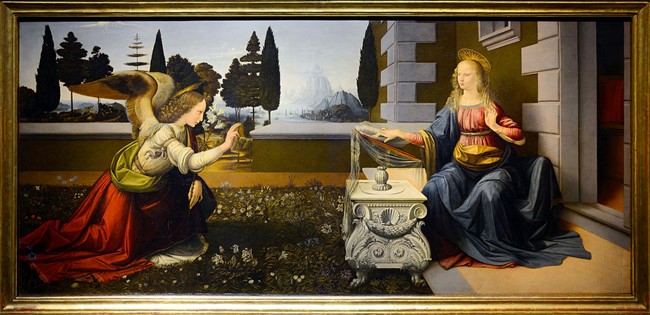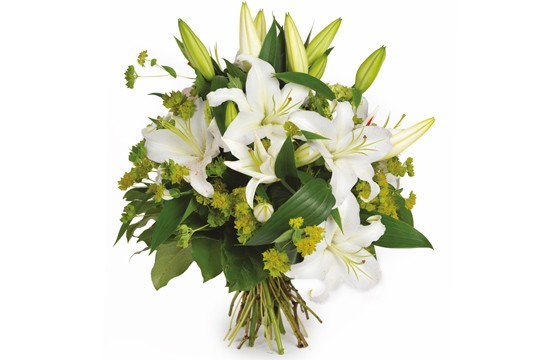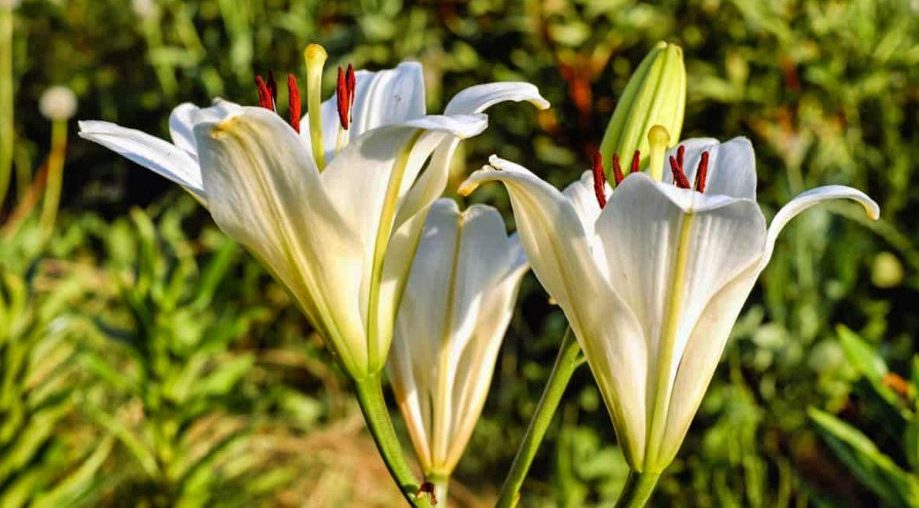Presentation of the lily
The lily flower belongs to the family Liliaceae and the genus Lilium which includes a large number of different species: a hundred or so. It is found throughout the world: in southern Canada, the United States, Japan, India, Asia and Europe. It grows more easily in mountainous or forest areas.
If the lily is highly appreciated, it is probably due to its opulent flower that consists of 3 petals and 3 sepals identical, ie six tepals. It is a flower that is very popular among florists because of its majestic appearance, its elegance and its varied colors: orange, pink, red, and of course white, but also speckled or spotted, they make bouquets great by mixing them with taste and skill. She is in the top 10 most loved cut flowers. It is very often used in certain ceremonies and in particular during weddings.
The lily blooms normally in summer, while in winter it enjoys a period of rest. However, you can buy them all year round at the florists, in this case they come from Dutch, French or Italian cultures and grow under glass.
Lilies are listed in four categories:
- Asian liliesThey are called Paris, Madras, Brunello … Their flowers are grouped in umbels or bunches, they are brightly colored and they are not perfumed.
- Eastern liliesThey are native to East Asia, the flowers are very large and it usually gives off a strong perfume. These upscale and luxurious species include some varieties like: Stargazer, Time out, Conca d'Or …
- Hybrid lilies: these are the rarest. They are usually pink or orange and come from a cross between Asian lilies and longiflorum lilies.
- Longiflorum liliesThey are found in the form of large white flowers that are often agglutinated at the end of the stem by two or three. These are the favorites of virtually everyone at wedding ceremonies. They come in two varieties: White Heaven and Snow Queen.
What is the meaning of the Fleur de Lys?
The lily has different meanings:
- Purity and beauty of youth
- Renewal and rebirth
- Fertility and motherhood
- The majestic pace and royalty
- Dynamism and passion
The white lily and its religious connotation evoke pure love and innocence. His royal past has left traces especially thanks to the golden lily and he is the emblem of noble feelings. Red, it refers to passion, orange, desire, yellow, friendship and enthusiasm and rose to tenderness and affection. By offering lilies, you also send a message to the recipient.
At the etymological level
Many real lily flowers exist in the world and they all belong to the Lilium family. However some lilies can not be considered as part of this classification, this is the case of the lily of water or the lily of a day. And this, because they can not get the name of real lilies. Lilium candidum is one of the first words for flower, you have to go back in time and travel through many civilizations to find it. It is a Latin term that is a derivative of the Greek word Leirion. This is how we find traces of the lily and its importance over the millennia.
The history of the Fleur de Lys
In 466-511 during the reign of Clovis, first King of France and kings of the Franks, it is the iris which is symbolic of the French monarchy. And this because the Virgin Mary was considered the protector of the Kings of France. However, do not confuse the iris with the fleur-de-lis which are not of the same family. They may look vaguely similar, but the legend that attributes the origin of the lily at this time can not be asserted. It seems that its origin is not so distant.
A small aside: fleur de lis or fleur de lys are just two spellings. Lily was little used during the seventeenth and eighteenth century, it became very common and became widespread from the nineteenth century and then especially in the heraldic sense of the term. Before being named fleur de lis, it was rather called queen of flowers or royal flower by the fathers of the Church. The heraldic lily evokes only from far away the lily of the gardens.
Fleur de Lys and Royalty
It was during the period from 823 to 877 that the fleur-de-lis first appeared on the spectrum of Charles the Bald, who was the king of western France. the emperor of the West, as well as the grandson of Charlemagne. The emblem was chosen by the French royalty as other royal families had opted for the leopard, the eagle or the lion.

However, it will prevail until the revolution on money, tapestries, fabrics, monuments, painting, objets d'art, statues, sculpture … It will adorn the coat of arms of many royal families or noble.
From Henry I, the diadem of kings is sometimes decorated with fleurs-de-lis. It will be vegetable for a long time and stylized only after King Saint Louis IX had decorated its second seal. All have not adopted this symbol, it is the case of Philip I and Louis VII who had preferred a kind of lotus.
As for Louis XVI on his crown were alternated, flowers of cross lilies, however its spectrum ended with a lily that resembled the heraldic lily. It was under his reign that Father Suger was at the origin of the Royal Basilica of Saint-Denis and offered him a large cross decorated with lilies. It is from this time that the currency regularly displays this flower. The kings of France will now put this one on their coat of arms.
The revolutionaries, opposed to the monarchy and the Church, destroy many works of art and historical sites adorned by this emblem. Nevertheless, it can still be seen on some buildings and monuments, less than before necessarily, but they are still present in all French landscapes and whatever the regions.
Its symbol
The coat of arms of the crown of France included three fleurs-de-lis. They recalled the Holy Trinity, the Father, the Son and the Holy Spirit, but also the time, the hope and the charity, the virtues of Catholicism. One could then evoke the symbolism of the king's submission to divine authority. This is where the notion of divine right comes from. Obviously, the king was sacred, emperor of his kingdom, and he held his crown of God and not of the people.
The lily is assimilated to the rays of the sun. Indeed, in the liturgy, we make the link between Christ and the light or the sun. It turns out that royalty itself was referring to the solar star. This is how we can make the connection between royalty and the Christian religion.
Still in the Christian tradition, the lily is a symbol of fertility, associated with the Virgin Mary, which gave her the nickname of the Lily of the Madonna or Lily of the Virgin. The churches whose patroness was Mary and the corporations under her protection put forward the lily. The white lily held by the angel Gabriel is reminiscent of Mary's purity.

Just like many saints, whose specter is adorned with fleurs de lys.
The maintenance of the Lily
The maintenance of the lily in the garden
If you want to decorate your garden with lily flowers, know that some species require very little maintenance, it is about so-called rustic lilies. You can perfectly enjoy in massive, but also in pots on a terrace or balcony. To plant them in vats, it is better to orient one's choice towards small plants.
You plant your bulbs by 4 or 5 per group in the spring or autumn. The depth is about 15 cm and should be spaced 20 cm. If the soil is rather too heavy and compact, then dig a hole 50 cm deep and cover the bottom with gravel to a height of 10 cm and mix it with a well decomposed compost or compost. It is best to avoid a place that is too exposed to direct sunlight, but not in the shade. If you have large varieties, put stakes to hold them.
>> To read also: 30 spring flowers: the most beautiful!
Water your plantations regularly especially during the hot season, spring and summer. Add water to the fertilizer every 15 days. The soil must remain moist without being soggy. In this case, the bulbs could rot. By mulching the floor, you avoid water loss in the summer and keep the ideal humidity level. In autumn, watering will be less frequent and non-existent during the winter.
Maintain her bouquet of lilies

By following a few rules and simple tips, you will easily keep your lily bouquet for several weeks.
Here are some indications:
- Cut the 3 cm stems with care, the leaves should not soak in the water
- Add cut flower food to the water without abusing it and do not forget to change the water regularly to maximize the life of your flowers
- Install your vase away from sources of heat, direct sunlight and drafts
- Do not place your bouquet of flowers near your fruit basket, the lily would suffer from the ethylene gas that emerges from them
Little extra tip:
The pollen on lily stamens is terribly messy and very difficult to clean on clothing and textiles. Simply remove the stamensbut gently so as not to damage the pistil which is in the center of the flower. And if in spite of everything, you make a stain, do not put water, but tap with tape.
Some properties of the lily:
It is antiseptic, anti-wrinkle and insecticidal because of the boric acid it contains in the bulb and petals.
You will like also :








